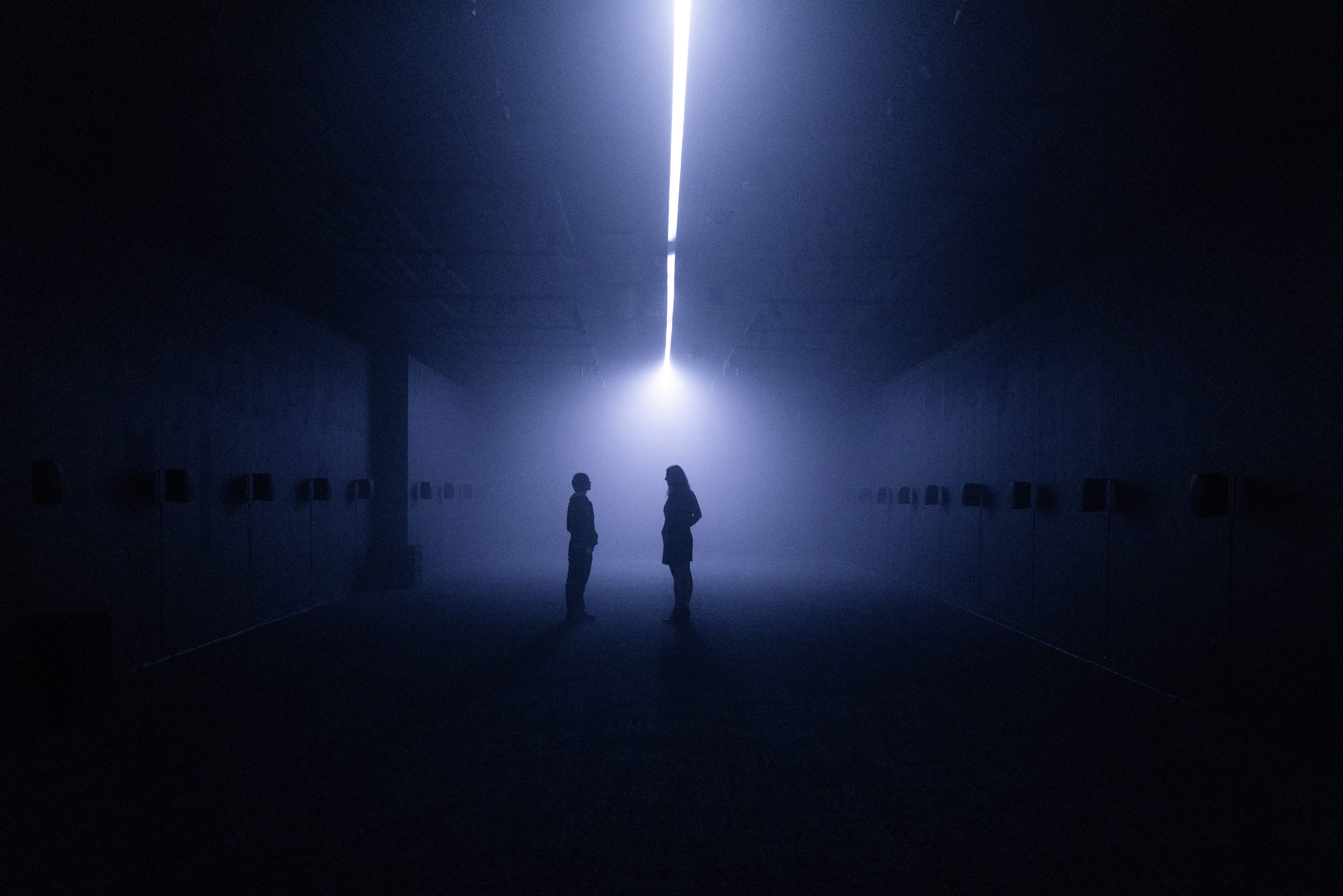Jónsi’s FLÓÐ (Flood) is a spatial scent and sound sculpture that conjures a cataclysmic event. In the gallery, we are transported to the sea. The scent of seaweed, tinctured and distilled by the artist, fills the air and a delicate mist touches our skin. Through the haze overhead, light penetrates the “
Currently on view at Reykjavík Art Museum Hafnarhús, FLÓÐ is one of three works in the artist’s eponymously titled exhibition—his first in Europe. FLÓÐ was created for Seattle’s National Nordic Museum in 2023, and the presentation in Reykjavík marks its second installation. Though it debuted in another coastal city 3,600 miles away, FLÓÐ has been embraced in Reykjavík, the capital of Jónsi’s home country and Seattle’s sister city. This connection between Reykjavík and Seattle was front-of-mind for Jónsi when he conceived of FLÓÐ.
As the curator who commissioned FLÓÐ for the National Nordic Museum, I discussed this relationship with Jónsi during the site visit that would inform its creation. The behind-the-scenes journey of curatorial commissions is rarely discussed. Yet, a work’s curation history can shine a light on the intentions behind its previous and current display, as well as its resonance for viewers. In January 2020, I flew to Los Angeles to visit Jónsi’s first exhibition with Tanya Bonakdar Gallery. I first learned of Jónsi’s work as a visual artist through art critic Gregory Volk’s Hyperallergic review, “Seeking the Soul of Iceland,” published the month prior. Jónsi has been a visual artist for decades, and Volk rightly characterized his work as a natural extension of his contributions as a performing artist—he is the lead vocalist for the internationally acclaimed post-rock band Sigur Rós—and in the artistic medium of scent. After I arrived at the gallery, I spent time with Hvítblinda (Whiteout), Svartalda (Dark Wave) and Í blóma (In Bloom) (all created in 2019), three multisensory installations that capture the complex natural environment and history of Iceland. Hvítblinda, a pristine white cube with two elevated platforms, calls to mind whiteout conditions. The scent of ozone permeates the air, while field recordings of wind and snow accompany the artist’s own vocals. Immediately, I decided that the museum must bring Hvítblinda to Seattle.
Conversations commenced with the artist. Yet, the ongoing uncertainty caused by the Covid-19 pandemic made it difficult to set exhibition dates. In the meantime, his second solo gallery show debuted: Hrafntinna (Obsidian), an immersive installation imagining the real-life eruption of Iceland’s Fagradalsfjall volcano in 2021. At the time, we planned a site visit. Jónsi and his studio manager Damon arrived in Seattle a couple of months later. We toured the museum, which is situated in the working waterfront of Seattle’s Ballard neighborhood. We drew comparisons between the cities and their vibrant fishing communities, and I noted Seattle’s longtime relationship with Reykjavík. (They became sister cities in 1986.) The next day, an idea emerged. Instead of installing Hvítblinda, we would create a new work, which would forecast how climate change and sea level rise challenge the survival of coastal cities and their residents.

As Jónsi developed his artistic vision for FLÓÐ, his studio and my installation team worked to realize it in the gallery over the course of the next year. With the support of exhibition sponsor Icelandair, I arranged for the artist and his team to travel to Iceland to make field recordings and gather North Atlantic seaweed. In Los Angeles, Jónsi composed and recorded the soundscape, created the scent and directed the programming of a long LED light strip. At the museum, the exhibition designer and I collaborated with our facilities crew to develop a plan to keep the installation’s seaweed scent and fog contained in the gallery of a state-of-the-art purpose-built facility, and we selected environmentally-friendly exhibition components in keeping with the organization’s sustainability efforts and the artwork’s message. For example, visitors would be encouraged to sit or lie on the floor of the gallery, and we would need to carpet its polished concrete floors. We purchased carpet tiles made from regenerated nylon that had previously been used in fishing nets.
As commissioning curator, I was also the first interpreter of this work for the public and charged with communicating the experience to the museum’s marketing and public relations teams. It was a new challenge to write about an experiential artwork during the process of its creation, but conversations with Jónsi and his studio manager informed my art historical analysis and understanding of the intended visitor experience. A few months before the exhibition was scheduled to open, Jónsi decided upon the artwork’s title, and the catastrophic tenor of the piece became clearer to me. I situated this new work of art within a broader context, tracing the history of the concept of the sublime landscape in art from the 18th to the 21st centuries with FLÓÐ.
The National Nordic Museum’s opening of FLÓÐ was its largest to date, with attendance swelling over the exhibition’s run. Visitors returned repeatedly and remained in the exhibition for hours. Inspiring awe, FLÓÐ immersed visitors in a sublime landscape—that of a human-made future in the Puget Sound region—and reminded them of their fragility amid the forces of nature. Comment cards, all positive, described stirred emotions. Visitors used terms, such as “calming” and “healing” to describe the work that they also acknowledged is “powerful” and “a religious experience.” Museum staff members grew so attached to the piece that they kept the branded sweatshirt, the design for which Jónsi and I had developed over coffee in LA, in the regular rotation of their wardrobes. Prior to de-installation, I reserved two hours for staff to say farewell to the work together. Fortunately, it was not my last experience with it. I had the privilege of revisiting FLÓÐ at the exhibition preview at Hafnarhús, situated near Reykjavík’s waterfront in June. True to the earliest conversations in 2021, FLÓÐ’s impact in Reykjavík was as profound as in Seattle.

